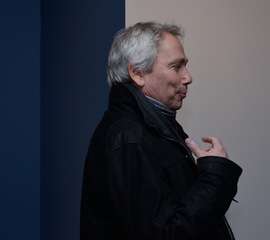|
Back
A Portrait of Philippe Leroux Toronto
The Betty Oliphant Theatre
12/06/2015 -
Elliott Carter: Canon for Three Equal Instruments
Philippe Leroux: AAA – Ailes
Gérard Grisey: Talea
Scott Rubin: less than equals three (world premiere)
Alexander Dobson (baritone)
Robert Aitken (flute/conductor), Dianne Aitken, Les Ault (flutes), Max Christie (clarinet), Gregory Oh (piano), Lynn Kuo, Corey Gemmell (violins), Carolyn Blackwell (viola), David Hetherington (cello), Rick Sacks (percussion), Erica Goodman (harp), Wallace Halladay (saxophone), Ian Cowie (trombone), Michele Verheul (bass clarinet), Graham Mackenzie (oboe), Christopher Gongos (horn), Robert Venables (trumpet), Jerry Robinson (contrabassoon), Adam Scime (contrabass) 
P. Leroux (© Daniel Foley)
French composer Philippe Leroux (born in 1959) has been teaching for some years at McGill University’s Schulich School of Music. This concert, the first of three in Toronto featuring his work, was titled “A Portrait of Philippe Leroux”, and the “portrait” consisted of two works by Leroux, one by a mentor/colleague, and one by a student of his. The concert was preceded by a discussion between Philippe Leroux, New Music Concerts director Robert Aitken, and composer Scott Rubin, a recent student of Leroux at McGill.
Philippe Leroux is said to compose in a “spectral” or “post-spectral” style. The problem with such labels is that, once applied, they become subjects of debate and eventually become “disowned”, discredited, derided, denied - you name it. The term refers to the full spectrum of sound which spectral (or post-spectral) composers seek to explore, as opposed to the preceding wave of composers who focused on structure. The 20 performers were deployed in various combinations for each piece, giving a wide array of sonic experience.
Leroux’s AAA dates from 1996; it is for seven players: flute, clarinet, violin, viola, cello, piano, and percussion, and is an instrumental version of an earlier electronic work Image à Rameau which was based on a keyboard piece La Poule by the 17th century composer. In no way does the work conjure up anything historicist, but it certainly is a scintillating piece that pulsates along with a display of converging and diverging tones from the various instruments. It amounts to a vivid demonstration of the composer’s focus on timbre, or the total spectrum of musical tone and colour.
The next piece was a world premiere by Scott Rubin, less than equals three, for eight players (flute, saxophone, trombone, harp, piano, violin, viola, and cello), with Robert Aitken conducting. It creates a physical sensation with frequent downward tonal plunges, with the trombone prominent. There are jazzy stretches with the saxophone prominent, and harpist Erica Goodman was given a lot of unusual manipulations for her instrument, using with a whole battery of tools. During the pre-performance discussion, Rubin stated that the low E on the trombone is a core note in the work. Some weeks prior to this performance he had a chance to hear a run-through by the Ensemble Intercontemporain (sight-readers extraordinaire, as one would expect) and found that it didn’t quite sound as he had intended, so changes were made for this premiere (an interesting insight into the composition process).
Scott Rubin entered the Schulich School in 2011 at which point he was introduced to the concept of spectral music and its focus on timbre. After receiving his masters degree there he is now working on his doctorate at Berkeley, where the Ensemble Intercontemprain recently visited. He also has a degree in psychology and has worked with the Auditory Cognitive Neuroscience Lab at McGill.
I don’t know what the title of the piece refers to but, but it certainly has a personality. I look forward to hearing more from this articulate composer.
We next heard a piece by a mentor/colleague of Leroux’s, Gérard Grisey (1946-1998) who is credited with co-founding the genre of spectral music.Talea, dating from 1986, is for five players: flute, clarinet, piano, violin, and cello. Its subtitle is “The machine and the rank weeds” and reading the composer’s translated notes is much harder work than listening to the intriguingly intricate piece. In Latin “talea” means a cutting, as in a plant to be grafted, and in Grisey’s piece, two sets of musical ideas are grafted together. It comes across as rather episodic building towards full “orchestral” effects then suddenly going small. There is a brief piano stretch reminiscent of one of Grisey’s teachers, Olivier Messiaen.
The biggest work on the program was Leroux’s Ailes (“Wings”) from 2012 for 15 players plus baritone. It is “an imaginary musical letter” to the composer’s brother who had died in 2010. One source of the work’s harmony was derived from the sound of bells (Mears bells) common in the province of Quebec. One might expect a commemorative work like this to sound funereal, liturgical or perhaps transcendental, but here there seems to be a lot of frustration, even anger - the composer’s notes contain the following words: vocal lament, suffering, aborted solos, anger, violence, not to mention “excessive, extreme frequencies”. As with Talea there are two musical strands interwoven - Leroux calls them “braids”. Baritone Alexander Dobson gave a committed performance of the challenging vocals, not all of them verbal - throaty sounds, hummed phrases, hoarse whispers, outbursts. The text by Leroux contains seemingly random phrases - I am sure I heard “la lumière porte l’obscurité” - the work invites intense listening.
Two days after this concert there were two more opportunities to hear a total of seven works by Philippe Leroux in what amounted to a mini-festival - unfortunately I was unable to attend.
The concert opened with a brief tribute to Elliott Carter (1908-2012), a frequent (and very stimulating) guest of New Music Concerts. His Canon for Three Equal Instruments (composed in 1971 as a tributes to Igor Stravinsky) was not composed for any specific instruments, but he made an arrangement for Robert Aitken to be performed by three flutes. The canon has two sections, the second one a variant of the first. Because of its brevity it was performed twice.
Michael Johnson
|